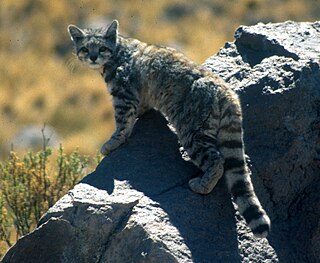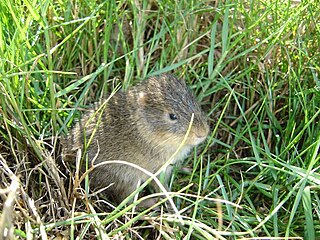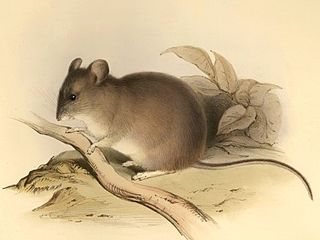
Caviidae, the cavy family, is composed of rodents native to South America and includes the domestic guinea pig, wild cavies, and the largest living rodent, the capybara. They are found across South America in open areas from moist savanna to thorn forests or scrub desert. This family of rodents has fewer members than most other rodent families, with 19 species in 6 genera in 3 subfamilies.

The Andean mountain cat is a small wild cat native to the high Andes that has been listed as Endangered on the IUCN Red List because fewer than 1,500 individuals are thought to exist in the wild. It is traditionally considered a sacred animal by indigenous Aymara and Quechua people.
The Andean rat, or white-tailed akodont, is the only species in the genus Lenoxus. It is a rodent in the tribe Akodontini found on the eastern slopes of the Andes of eastern Peru and western Bolivia. Examination of its genome shows that this species is not closely related to Oxymycterus as had previously been thought, but is quite distinct, having diverged from the other Akodontini soon after the basal radiation of the entire group.

Caviinae is a subfamily uniting all living members of the family Caviidae with the exception of the maras, capybaras, and Kerodon. The subfamily traditionally contained the guinea pig or cavy-like forms along with the cursorially adapted (running) Kerodon. Molecular results suggest the Caviinae as so defined would be paraphyletic and Kerodon is more closely related to maras and capybaras than to other caviines. This led Woods and Kilpatrick (2005) to unite Kerodon and capybaras into the subfamily Hydrochoerinae within the Caviidae. These studies also suggest Microcavia and Cavia are more closely related to one another than either is to Galea.

The Andean tinamou is a tinamou, found commonly in high-altitude shrubland, in the Andes of South America.

Santa Catarina's guinea pig or Moleques do Sul cavy is a rare guinea pig species of southeastern South America.

Spix's yellow-toothed cavy is a rodent, a cavy species from South America. It is found in Bolivia east of the Andes and much of south central to northeastern Brazil. The species is found in open savanna and semiarid habitats, such as the Cerrado and Caatinga of Brazil. Its karyotype is 2n = 64 and FN = 118.

The acrobatic cavy also known as the Acrobatic Moco and Climbing Cavy is a cavy species native to Brazil in the Amazon rainforest. It is found from Goiás state to Tocantins state, west of the Espigão Mestre, Serra Geral de Goiás, and is also found in Terra Ronca State Park.

The yellow-rumped leaf-eared mouse, otherwise known as the Patagonian leaf-eared mouse, is a species of rodent in the family Cricetidae and order Rodentia. It is the most widespread member of the genus.

The Andean gull is a species in subfamily Larinae of the family Laridae, the gulls, terns, and skimmers. It is found in Argentina, Bolivia, Chile, Colombia, Ecuador, and Peru.

The mountain parakeet, also known as the golden-fronted parakeet, is a species of parrot, one of two in the genus Psilopsiagon within the family Psittacidae. It is found in the Puna grassland. Its natural habitat is subtropical or tropical high-altitude shrubland. Four subspecies are recognised.
The common yellow-toothed cavy is a species of rodent in the family Caviidae, closely related to the domesticated guinea pig. It is found in Argentina, Bolivia, Chile, and Peru. Its karyotype has 2n = 68 and FN = 136. G. musteloides is the most common and widely found member of Galea, and is present at elevations ranging from 20 to 5000 m above sea level. It has yellow teeth.

The northern viscacha is a species of viscacha, a rodent in the family Chinchillidae. It is known from Peru and Chile, at elevations from 300 to 5000 m, and may also be present in Bolivia.

The southern mountain cavy is a species of South American rodent in the family Caviidae.

Microcavia is a genus of rodents in the family Caviidae. They are unique within their family in that their premolar teeth do not grow and replace the original deciduous cheek teeth until after the animal is born; in other genera this occurs in the womb.
Shipton's mountain cavy is a species of rodent in the family Caviidae. It is endemic to Argentina.

The Muenster yellow-toothed cavy is a species of rodent in the family Caviidae. It is known only from one location in Valle Hermoso in the Bolivian Andes, at an elevation of 2557 m. Specimens from this location were shipped to Muenster, Germany in 1997 for laboratory research, where the species was recognized and described. Galea monasteriensis was recognized on the basis of morphological, behavioral, and reproductive differences from related species. However, its habits in the wild have not been studied.

Galea is a genus of South American rodents of the family Caviidae. 5-6 extant species are known, found in Argentina, Bolivia, Chile, Peru and Brazil. They are:













